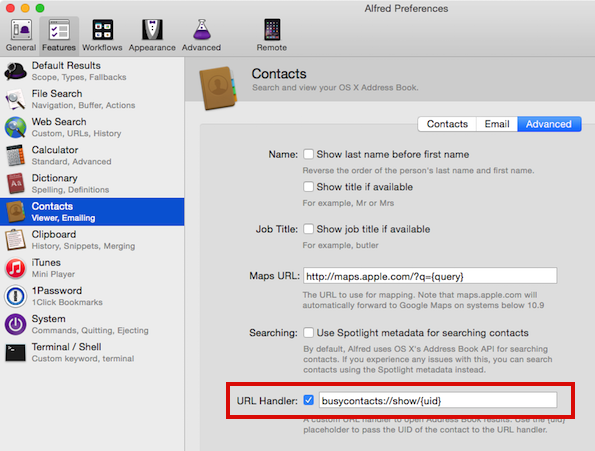URL Handler
BusyContacts supports URL handlers for showing a contact and creating a new contact.
Following is a sample contact vCard that will be used in the examples below.
BEGIN:VCARD
VERSION:3.0
PRODID:-//Apple Inc.//Mac OS X 10.8.2//EN
N:;;;;
FN:Apple
ORG:Apple;
EMAIL;type=INTERNET;type=pref:test@apple.com
X-ABShowAs:COMPANY
UID:f90221ac-84a8-4f40-a699-5930b59a24d1
X-ABUID:B8FB81A6-659D-4E66-B1B7-97A95A144C83:ABPerson
END:VCARD
Showing Contacts in BusyContacts
You can show a contact in BusyContacts by opening the busycontacts://show/ URL. It takes 1 parameter, either the UID, X-ABUID, or an email address of the contact. The parameter must be URI encoded.
Here are some example URLs to show the sample contact:
busycontacts://show/test@apple.com
busycontacts://show/f90221ac-84a8-4f40-a699-5930b59a24d1
busycontacts://show/B8FB81A6-659D-4E66-B1B7-97A95A144C83:ABPerson
To open the contact in a separate floating window, use busycontacts://open/ instead (supported in v1.6.7+).
Opening Contacts in BusyContacts from Alfred
If you're using Alfred, it can be configured to open contacts in BusyContacts instead of macOS Contacts. Note: Alfred 2.7.2 and BusyContacts 1.0.3 or later are required.
Open Alfred > Preferences > Features > Contacts > Advanced. Check the URL Handler checkbox and enter "busycontacts://show/{uid}" without the quotes.

Now when you search for a contact in Alfred and open it, it will be opened in BusyContacts.
Contact the developers of Alfred if you need help configuring Alfred to open contacts in BusyContacts.
Opening Contacts in BusyContacts from LaunchBar
If you're using LaunchBar, it can be configured to open contacts in BusyContacts instead of macOS Contacts. Note: LaunchBar 6.2.1 and BusyContacts 1.0.3 or later are required.
Currently, LaunchBar does not expose a UI for setting BusyContacts as the default app to open contacts from LaunchBar, but it can be configured using Terminal.
- Quit LaunchBar.
- Launch Terminal (in /Applications/Utilities).
- Paste the following text and press return:
defaults write at.obdev.LaunchBar ShowInAddressBookURLPrefix "busycontacts://show/" - Quit Terminal.
- Launch LaunchBar.
Now when you search for a contact in LaunchBar and open it, it will be opened in BusyContacts.
If you wish to reset this setting and use macOS Contacts as the default app to open contacts from LaunchBar, repeat the steps above and replace the pasted text in step 3 with this:
defaults delete at.obdev.LaunchBar ShowInAddressBookURLPrefix
Contact the developers of LaunchBar if you need help configuring LaunchBar to open contacts in BusyContacts.
Opening Contacts in BusyContacts from other apps
In addition to launchers like Alfred and LaunchBar, it may be possible to configure other third-party apps to open contacts in BusyContacts using the following information.
Third-party apps open contacts in macOS Contacts using the addressbook://X-ABUID URL scheme. To open the contacts in BusyContacts instead, the third-party app needs to be configured to pass the X-ABUID to busycontacts://show/X-ABUID instead.
For example, the following URL will open a contact in macOS Contacts:
addressbook://B8FB81A6-659D-4E66-B1B7-97A95A144C83:ABPerson
If you change the addressbook:// prefix to busycontacts://show/, the contact is opened in BusyContacts:
busycontacts://show/B8FB81A6-659D-4E66-B1B7-97A95A144C83:ABPerson
Contact your third-party app developer for help opening contacts in BusyContacts.
Creating new contacts in BusyContacts
You can create a new contact in BusyContacts by opening the busycontacts://new/ URL. It takes 1 parameter, a natural language string that represents the new contact. You can optionally include a hint for the name of the address book to put the new contact into via a " /Hint" suffix. The parameter string must be encoded.
Here are some example URLs to create a new contact
busycontacts://new/Bob%20Jones%20555-1212
busycontacts://new/Bob%20Jones%20123%20Main%20Street,%20Anytown%20USA%20/iCloud
XCode sample code
If you are an app developer, following is sample code in Objective-C.
Here is sample code to programmatically show a contact:
- (void)busycontactsShowContact:(NSString *)uidOrEmail
{
NSString *url = [NSString stringWithFormat:@"busycontacts://show/%@", [uidOrEmail stringByURIEncoding]];
[[NSWorkspace sharedWorkspace] openURL:[NSURL URLWithString:url]];
}
Below is a category on NSString for URI encoding a string:
@interface NSString (URIEncoding)
- (NSString *)stringByURIEncoding;
@end
@implementation NSString (URIEncoding)
- (NSString *)stringByURIEncoding
{
// same as -stringByAddingPercentEscapesUsingEncoding but escapes '/' and '?'
const CFStringRef leaveUnescaped = NULL;
const CFStringRef forceEscaped = CFSTR("!*'();:@&=+$,/?%#[]");
CFStringRef escapedStr = CFURLCreateStringByAddingPercentEscapes(kCFAllocatorDefault,
(CFStringRef) self, leaveUnescaped, forceEscaped, kCFStringEncodingUTF8);
return [NSMakeCollectable(escapedStr) autorelease];
}
@end